 |
|

|
 |
TABLE of CONTENTS
|
Hwy 14 project adds 12 miles of four-lane roadway between Janesville, Waseca |

While celebrating the completion of the Hwy 14 reconstruction project from Waseca to Janesville, the governor and lieutenant governor announced that another four-lane expansion project of Hwy 14 from Waseca to Owatonna will begin in 2008. Photo courtesy of Minnesota State University, Mankato |
Sept. 8 marked the official completion of Hwy 14 between Janesville and Waseca, featuring 12 additional miles of four-lane roadway.
On hand to celebrate the achievement were Gov. Tim Pawlenty, Lt. Gov./Commissioner Carol Molnau, community leaders and transportation officials.
Work on Hwy 14 from Waseca County Road 60 on the west side of Janesville to Waseca County Road 2 on the west edge of Waseca began in July 2004.
The $35 million project was completed three years ahead of schedule because of funding from the 2003 Pawlenty-Molnau Transportation Finance package, which helped accelerate work on Hwy 14 and other projects in the state.

Mankato/District 7 Engineer Jim Swanson speaks at the Hwy 14 celebration Sept. 8 near Janesville. With him are Waseca County Commissioners Richard Androli and Jim Peterson. Photo by Wendy Meyer |
The governor and lieutenant governor also announced that construction of a four-lane expansion of Hwy 14 from Waseca to Owatonna will begin in 2008. Completion is scheduled for 2011.
"This $130 million expansion project will continue the improvements we have seen thus far on Hwy 14 to improve safety and mobility," said Molnau. "The Hwy 14 corridor has needed improvement for a long time and we are excited that we are able to secure the funds needed to get this next phase going."
For more information about the Hwy 14 project, see http://www.dot.state.mn.us/d7/projects/14owatonna/.
|
 |
|

|
 |
TABLE of CONTENTS
 |
MnPASS I-394 Express Lanes surpass 10,000 transponder leases |
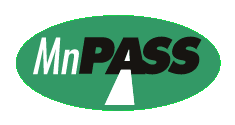
Mn/DOT opened the MnPASS I-394 Express Lanes in May 2005 as a way to better use the capacity in the high occupancy vehicle lane on I-394. The department recently surpassed leasing the 10,000th transponder for the Express Lanes. |
By Kevin Gutknecht
Mn/DOT recently issued its 10,000th transponder for the MnPASS I-394 Express Lanes, Minnesota's first toll road.
The transponder is the small electronic device that users attach to windshields to interact with recording equipment located on the road. Tolls are automatically deducted from a pre-paid account, and fees vary by time of day and level of traffic congestion.
The 10,000th MnPASS subscriber is a driver from Prior Lake, Minn.
"This is an important milestone for MnPASS I-394 Express Lanes," said Lt. Gov./Commissioner Carol Molnau. "We have reached this mark sooner than expected when we opened the lanes last year. This is an indication that travelers in the corridor see the benefits of the Express Lanes and are choosing them as a way to get to their destinations more predictably."
Mn/DOT has been evaluating operations and public perception of the Express Lanes during the last year. The MnPASS lanes have met the objective of better using the capacity in the high occupancy vehicle lane and have reduced congestion in the adjacent free lanes, she said.
"Since the lanes have opened, we see an average increase of more than 1,200 vehicles moving through the lanes during peak rush hours," she said. "With those vehicles moving to the Express Lanes, average speeds have increased in the regular lanes from 2 percent to 8 percent during peak rush hours."
Molnau added that research indicates that speed in the MnPASS Lanes is at or above 55 miles per hour 95 percent of the time.
In terms of revenue, the Express Lanes have been meeting expectations, she said. The MnPASS lanes are currently averaging $4,400 a day in toll and fee revenue, which is allowing the Express Lanes to meet operating expenses.
Mn/DOT opened the MnPASS I-394 Express Lanes in May 2005 as a way to better use the capacity in the high occupancy vehicle lane on I-394. The lanes are open at all times to transit, carpools and motorcycles. During specific hours of operation, they are also open to motorists who pay a fee to subscribe to the system.
The MnPASS Lanes have received four state, national and international awards since opening.
Molnau added that future MnPASS expansion will depend on how such facilities fit into state transportation plans, funding availability and public desire for toll roads. There are no immediate plans to open more MnPASS lanes, she said, although there may be further study.
For more information on MnPASS, visit www.mnpass.org.
|
 |
|

|
 |
TABLE of CONTENTS
 |
New traffic signal in Mendota Heights is first of its kind |
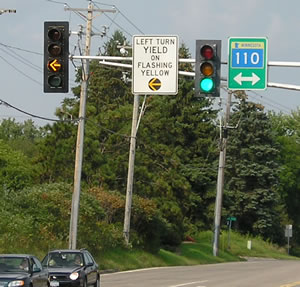
The new signal at the intersection of Hwy 149 and Hwy 110 in Mendota Heights allows motorists to make a left turn on a flashing yellow arrow after yielding to oncoming traffic. Photo by Kevin Gutknecht |
By Kevin Gutknecht
Mn/DOT installed a new set of traffic signals in Mendota Heights recently that are the first of its kind in the state, and should make traffic move more smoothly.
The new traffic signals were installed Sept. 6 on Hwy 149 at its intersection with Hwy 110 in Mendota Heights. They feature a flashing yellow arrow, in addition to the standard red, yellow and green arrows.
When illuminated, the flashing yellow arrow allows waiting motorists to make a left-hand turn after yielding to oncoming traffic. Otherwise, the new traffic signal works the same as traditional signals.
The new signal allows traffic that normally has had to wait for a green left turn signal to turn if there is no oncoming traffic, according to project manager Jerry Kotzenmacher, Office of Traffic, Security and Operations.
Kotzenmacher said the Mendota Heights site is a pilot project. Mn/DOT will evaluate its operation before deciding on other locations for the new signal.
The Hwy 149/Hwy 110 intersection was chosen because of relatively low traffic volumes and because it involves two state roadways.
|
 |
|

|
 |
TABLE of CONTENTS
 |
Drive to Excellence program seeks statewide fleet management system |
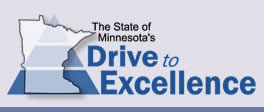
Stemming from one of the state's Drive to Excellence initiatives, the M5 fleet management information system will help identify ways agencies can share vehicles, maintenance facilities, staff expertise and other resources. |
By Craig Wilkins
Measures that would increase the effectiveness of the state’s vehicle fleets gained momentum with their recent inclusion in the state’s Drive to Excellence program.
The new DTE initiative stems from an initiative by Mn/DOT and other agencies with large fleets to find better ways to manage them and to share vehicle-related services.
Fleet management is one of eight initiatives DTE supports to streamline the delivery of state services. Other initiatives include simplifying the purchase of state licenses and managing state-owned property.
The fleet management project team’s first recommendation calls for implementing the M5 fleet management information system to identify ways agencies can share vehicles, maintenance facilities, staff expertise and other resources, said Mark Wikelius, Mn/DOT’s DTE program director.
The project team submitted its proposal to the DTE’s Project Advisory Team Sept. 15. Upon the advisory team’s approval, the recommendations will be forwarded in October to the DTE Sub-Cabinet for its review and approval.

Snowplows like these in Detroit Lakes/District 4 will be accounted for in the statewide adoption of the M5 system. Photo by Bill Hanson |
Mn/DOT currently works with the departments of Administration, Natural Resources and Public Safety to define a shared-services approach to fleet management practices, Wikelius said.
Statewide adoption of the M5 system, he said, would increase access to specialized equipment, lower equipment costs from increased cooperative purchasing agreements and better use of staff and vehicle maintenance and repair.
He said, for example, that sharing information might enable a state agency that plans to outsource vehicle maintenance to instead use a state resource, such as a Mn/DOT shop, to perform the work if its workload allows.
State agencies have a total of about 8,000 vehicles including cars, pick-ups and heavier trucks that can be licensed and driven on public roads. The state’s inventory also includes loaders, bulldozers, tractors and other equipment.
The recommended plan, Wikelius said, calls for Mn/DOT, the DNR and Administration to begin using the M5 system in January. DPS would join the system in July 2007; all other agencies would become part of the M5 system in 2008.
The initiative also recommends that a fleet management advisory council from participating agencies plus the departments of Human Services and Corrections oversee the start of the new shared services approach.
“What we are seeking is to ensure that we use the shared services model to make the best use of our resources and expertise to operate a vehicle fleet that is as efficient and flexible as possible,” Wikelius said.
|
 |
|

|
 |
TABLE of CONTENTS
 |
New statewide cell phone plan means changes in vendors, usage policy |
|
By Donna Lindberg
Beginning Oct. 1, a new cellular phone plan could affect Mn/DOT employees who currently use a state-owned cellular phone for business and personal calls.
“Cell phone changes are the result of a Drive to Excellence project to create consistency among all state agency phone plans and achieve greater cost savings,” said Mark Wikelius, Mn/DOT’s Drive to Excellence director. “As a result of changes in vendors and plans, the statewide cell phone policy also changed.”
Under the new plan, the state narrowed its vendors to three—Unicel in the northern part of the state, Midwest Wireless in the south and Sprint/Nextel centrally.
“We should be able to achieve lower rates and overall costs,” said Mike Garza, director, Office of Civil Rights and Administrative Services. “To achieve this, DTE's intent is to move toward more pooled minute plans rather than individual cell phone plans for everyone with a cell phone. By pooling minutes and sharing plans for multiple users, we can take advantage of lower cost per minute rates and thus an overall reduction in cost.
“For example, one office was able to pool approximately 50 users into one plan and save 50 percent of the cost paid for the multiple plans with individual plans. In concept, it should work,” he said.
Many Mn/DOT employees who now use state-owned phones for business should continue to do so.
“State-owned cell phones should be available to employees in positions where the associated benefits justify the additional operating costs,” said Sue Heurung, manager, Business Services Section, Office of Civil Rights and Administrative Services. “This includes employees who travel or have job responsibilities that include being outside of the office or need to be accessible for extended periods.”
Employees who continue to use state-owned cell phones will be able to use them for essential personal calls in urgent situations.
“Examples of essential personal calls are calls to arrange for care of a child, communicate during a family emergency, alert a family member of an unexpected delay due to a change in work schedule or arrange for transportation or service in the event of car trouble,” said Heurung.
“Many offices are purchasing one or more phones that will be available to their employees on an occasional basis for business purposes,” said Heurung. “This will help minimize the additional time and expense previously required to reimburse employees who sometimes used their personal cell phones for business.”
- For more information about how statewide cell phone changes may affect you, talk with your supervisor.
- The revised statewide electronic communication and technology policy can be found on the Department of Administration Web site.
- Information on cell phone contract and policy changes, including answers to frequently asked questions, is available on the Drive to Excellence Web site.
|
 |
|

|
 |
TABLE of CONTENTS
 |
Former assistant commissioner Dave Ekern appointed commissioner of Virginia DOT |
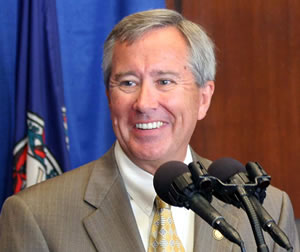
Dave Ekern, former Mn/DOT assistant commissioner for national affairs, accepts his appointment Sept. 8 as the new commissioner of the Virginia Transportation Department. Photo courtesy of state of Virginia Governor's Office |
Dave Ekern, former assistant commissioner for national affairs, was appointed Sept. 8 to the position of commissioner of the Virginia Transportation Department.
Ekern left Mn/DOT in July 2003 to become Idaho’s director of transportation.
Ekern has 35 years of experience in transportation. Other positions he has served within Mn/DOT include as district engineer for Duluth/District 1 and Willmar/District 8, and acting district engineer for Rochester/District 6. He has been a director for Mn/DOT’s offices of Environmental Planning, Highway and Area Planning, and Engineering Services.
Ekern holds a master’s degree in business administration from the University of St. Thomas and a bachelor’s degree in civil engineering from the University of Minnesota. Ekern is a registered professional engineer and has earned the standing of Fellow from the American Society of Civil Engineers.
The Virginia DOT has a workforce of nearly 10,000 employees and an annual budget of about $4 billion.
For more information about Ekern’s appointment, see the state of Virginia news release.
|
 |
|

|
 |
TABLE of CONTENTS
 |
Agents needed fortitude, patience to obtain rights of way for interstate system |
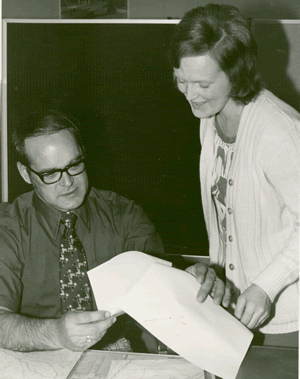
Carol Jeglum reviews a file with Ken Heim, a retired right of way agent at Rochester, during the early 1980s. Jeglum is still employed by Mn/DOT and now serves as a real estate representative herself in District 6. Mn/DOT file photo |
Acquiring right of way for the interstate system was not a job for the weak-of-heart.
ROW agents continually endured tedious searches for property titles, hostile land owners and long days in court to obtain properties needed to build the new freeway system.
They were frequently threatened, bullied and vilified in the course of their duties.
They prevailed, however, by using their expertise, resourcefulness and empathy when working with people whose lives would change, often significantly, when Mn/DOT acquired their property.
Some agents became advocates for their clients, especially the poor and the elderly, when freeway construction required them to relocate.
To read a few of their stories, visit Mn/DOT’s 50th Anniversary of the Interstate Highway System Web page: www.dot.state.mn.us/interstate50. The page also includes new entries in its Memories section, including a poem written by Loren Ingebretsen of Felton, president of the Minnesota Association of Townships.
|
 |
|

|
 |
TABLE of CONTENTS
 |
Mn/DOT’s emergency management communications efforts receive national recognition |
|
Whether it’s just a stalled vehicle or a terrorist incident alongside the road, good communications between emergency response agencies is important to efficient, timely emergency response.
Michael Ritchie, hazardous materials specialist, Office of Freight and Commercial Vehicle Operations, recently received national recognition from the Institute of Electrical and Electronics Engineers for his efforts to improve electronic communications during hazardous materials incidents.
“Emergency response departments are often able to communicate well with their own personnel, but not necessarily with other departments,” Ritchie said.
Ritchie leads a hazardous materials committee of the Incident Management Communications Working Group made up of representatives from state and local transportation departments, the Federal Highway Administration, the American Association of State Highway Transportation Officials, police and fire departments and industry.
The group recently revised an intelligent transportation systems standards document to help improve electronic communications during a transportation related incident. The document, “IEEE Standards for Hazardous Material Incident Management Message Sets for Use by Emergency Management Centers,” was published with the help and funding from the IEEE, AASHTO and the U.S. DOT.
“Representatives from the private sector including engineering companies and transportation manufacturers like Lockheed Martin also participated in the development of the standards because they could ultimately be useful to their efforts,” Ritchie said.
Communication from one department computer to another department computer is often difficult during an incident.
“These standards allow computer compatability to help police, fire, hazmat teams, highway incident responders (like Mn/DOT’s Freeway Incident Response Team), highway maintenance staff and traffic management centers share information center-to-center, center-to-mobile units, and mobile-to-mobile so they can help each other,” Ritchie said.
The hazardous materials standard is one of three published “companion standards” that include standards for traffic management centers and public safety agencies. A proposed fourth standard addressing communications between mobile data terminals and dispatch centers has recently been released by the IEEE.
“These standards have been around for awhile but have to be updated regularly as technology changes and in response to federal requirements that all equipment terminology is consistent with the National Incident Management System,” Ritchie said.
The Incident Management Communications Working Group made a presentation in April 2005 on the incident management standards to the New York City police and fire departments as well as state and city departments of transportation.
“New York is one of the first states to implement the standards,” Ritchie said. “They were also used in part for the 2002 Salt Lake City Olympics.”
Ritchie also received recognition in 2003 from the IEEE for his part in developing the original standards.
“When I travel to national conferences and meet with experts in the area of hazmat regulation and emergency response, they always ask if I know Mike Ritchie,” said Cecil Selness, FCVO director. “Mike has a great national reputation.”
|
 |
|
| |
|



